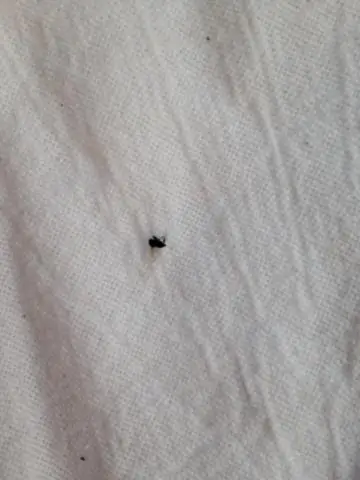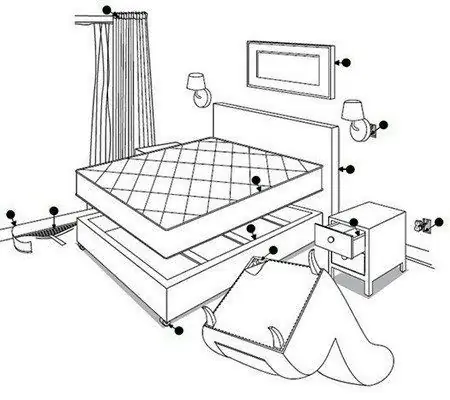
Table of contents:
- Author Bailey Albertson [email protected].
- Public 2023-12-17 12:53.
- Last modified 2025-01-23 12:41.
Simple ways to deal with moles at their summer cottage

Spring is coming, the time for gardening. These are not only pleasant chores, but also the necessary worries to protect the site from pests. Moles become a real natural disaster for the gardener during this period. Although these animals are considered useful in many ways, they most often become the main enemies for summer residents. It is unlikely that anyone will like completely spoiled beds, so the fight against moles becomes a top priority.
Content
- 1 Mole habitats
- 2 How to start protection in time and make it effective
-
3 Folk remedies for fighting moles
- 3.1 We use insecticides and mechanical traps
- 3.2 Electronic Mole Repeller
- 4 Do-it-yourself scarers
- 5 Video on how to deal with moles
Mole habitats
First you need to find out who the mole is and where it usually lives. Moles are small carnivorous animals up to 15 cm in size and weighing about 120 grams. Their benefit lies in the fact that they loosen the soil, providing oxygen to the roots of plants, and eat harmful insects living in the soil. This also determines the harm caused by moles: they destroy the root system of garden plantings, causing irreparable damage to the crop.
For habitat, the mole can choose any type of soil, but prefers moist soil, easy to dig. Due to blindness, these animals mainly live underground, occasionally climbing to the surface, mainly in the dark.
In order to understand how to properly remove moles from the garden without harming the beds, you need to understand the structure of a wormhole.
- The main nest of the burrow, or bedroom, is located in the center of the entire system, most often under the roots of bushes or trees, at a depth of up to a meter.
- The nest is surrounded by two circular passages. They are connected to each other and to the bedroom. These sites are intended for resting and raising cubs.
- Main passages are located at a depth of 10 to 30 cm from the surface. From them through the "molehills" the animal pushes the earth to the surface.
- Stern horizontal passages are laid directly under the surface, approximately 5 cm deep. They look like an earthen roller and most of all spoil the appearance of the lawn. There can be a huge number of such moves.

Layout of a wormhole with passages
The mole works tirelessly, and does not even hibernate. If these animals are bred on your site, in the spring, after the snow melts, you can easily notice the fruits of their vital activity on the soil. So it's time to act.
How to start protection on time and make it effective
The more you put off the work of protecting your site from moles, the more time you will lose, so do not bring up the image of a cute, good-natured animal in your mind. Start as soon as you see the first signs of activity. Otherwise, the network of holes and tunnels will entangle the whole garden, and nothing useful will remain from your plantings.
Defense measures must be continued constantly, even if it seems to you that the moles are completely destroyed, because new moves do not appear. It is quite possible that the animal temporarily hunts somewhere nearby, and will eventually return to its habitable place. You have to start all over again.

Moles tend to return to an equipped place.
Moles have been fought with for centuries, and there are many ways to help you get rid of these annoying animals. Among them are both folk and modern. The methods of influence are also different, from expulsion from the territory to destruction. What exactly to choose depends on your preferences and capabilities.
Folk remedies for fighting moles
Once upon a time, cats were used to protect against moles. Now such a method is in doubt: domestic cats are unlikely to hunt for nimble animals, despite the fact that at home they will have food in any case. Therefore, we will consider more efficient ways.

You can fight moles with improvised means
- Break the reed stems from 1.5 to 2 meters long, peel and place in each mole in a tube. About 60-80 centimeters should remain on the surface. Under the influence of the wind, this structure creates an effect similar to the howling of wind in pipes. Moles have very keen hearing, and such sounds annoy them. After a week, the animals leave the site.
- Various turntables and ratchets work in a similar way. They need to be installed in several places on the site. It could be a simple tin can tied to an iron bar. These devices in the wind create noise and vibration that scare the moles and make them leave your land.
- Moles have a very keen sense of smell, and they react to strong, pungent odors. These animals do not like to be close to the beds with onions, garlic, hot peppers and other similar plants. There is a minus in this method: the mole will simply stay away from such a site, but will not leave your garden, but will make bypass tunnels.
- The use of plants in the fight against moles is very popular. These animals do not like legumes and bulbs such as daffodils, decorative onions, imperial hazel grouse and Siberian grove.
- There is a reliable, but very labor-intensive way. Along the perimeter of the entire site at a depth of 70-90 cm, you need to dig in hard materials: linoleum, tin or slate. They will not let moles from neighboring areas come to you and will not allow your "lodgers" to go away for a while and hide.
- Flooding of underground mole systems is often used. This method is not always effective. Firstly, you need a lot of water, and secondly, moisture will attract earthworms - a favorite delicacy of moles, and thirdly, a mole can have time to escape, and eventually return and continue its occupation.
- The "pot trap" is considered the best option. Find an active mole, put a saucepan or a jar in the middle below its level, and cover the passage with something dense that does not allow light to pass through. The mole will fall into a vessel, and if there is water in it, it will drown.
It is unlikely that these funds will bring a 100% positive result. Moles can escape for a while, and then return. Therefore, in our time, it is better to use modern means.
We use insecticides and mechanical traps
To combat rodents, zinc phosphide baits are most often used. Some gardeners question their effectiveness. Since the mole is a predator, it will be more interested in beetles, worms and larvae, rather than poisoned grass.
A good way to deal with moles is the complete removal of their favorite treats from the site, the same beetles and worms. This can be done with insecticides. But it is worth remembering that with an irresponsible approach, such a method will harm the soil, and therefore your crop. Choose poisonous substances carefully and use them in reasonable doses. In addition, earthworms benefit the soil in your area.
Poisonous gas bombs also refer to methods of chemical attack on moles. Gas is launched into the mole and fills the passages. The disadvantages include the fact that the gas may not reach all the passages and holes if the mole has built a too branched system.
Mechanical mole traps are of several types:
- traps;
- crossbows;
- noose.
Such traps show great efficiency, especially if there are still few moles. Tunnel mole traps are among the best options. They represent a piece of plastic pipe, both ends of which are closed with tin valves. They are fixed in such a way that the mole can climb inside, but cannot get out.

Tunnel mole trap
The most important thing is to place the mole trap in the right place. It must be an active mole. Open it and set the trap inside, and cover the top with a dense material that will not let light through: a piece of linoleum, plywood, a board. Check the trap from time to time and clear out the moles that have fallen into it.
Electronic mole scarers
These devices are considered the most effective and safest in pest control. What is especially attractive about them is that they do not harm the moles, but simply drive them away from the site and do not allow them to return for a long time. Electric scarers are the best option, they are environmentally friendly and do not harm your entire plot: soil, plants, earthworms, but they will save you not only from moles, but also from voles, rats, bears, shrews and other pests.
The operation of these devices is based on the fact that they generate sound vibrations at low frequencies of 300-400 Hz, which are very unpleasant for moles. During operation, the repeller spreads vibrations over the area, and the animals simply run away.

Electronic Mole Repeller
The most important thing is to calculate the required number of scarers and install them correctly. To do this, use our tips.
1st tip: the repellents must be installed tightly. Blind moles are guided by hearing, smell, and touch and respond to vibrations emitted by the device. Do not install the repeller directly into the burrow - it must be in full contact with the soil. Dig it in so that the lid protrudes literally 5 cm above the surface, and tamp the soil.
2nd tip: you need to consider the obstacles underground. The type of soil, the geometry of the site, the presence of outbuildings and depressions - everything can matter:
- the radius of action of the scarer is from 20 to 25 m, the denser the soil, the wider the radius;
- if the area is elongated, you need to calculate the number of scarers based on a distance of 25 m;
- if the size of the plot is more than 6 acres, install the scarers in a checkerboard pattern at the same distance;
- depressions, wells and foundations prevent the propagation of vibrations, blind spots are formed behind them;
- buildings that are not located on a permanent foundation are not an obstacle.
3rd tip: treat the repeller with care. This is a very fragile device, so it must be carefully lowered into the prepared hole, covered with earth and tamped.
4th tip: the device needs to be rearranged from time to time. The mole can get used to the location of the signal point and learn to bypass it. Therefore, it is recommended to reinstall the repeller several times per season.
Do-it-yourself scare devices
You can independently make a structure that will protect your site from moles. To do this, you need:
- plastic bottle;
- metal rod;
- part of the water pipe.
It is easy to make such a device.
- Drive the pipe into the ground so that its edge is below the level at which the passages were dug.
- Install the pin on top of the part of the pipe that is driven into the ground. Secure the pin with a plug.
- Punch a hole in the bottom of the bottle with a hot nail. Its diameter must be larger than the diameter of the pin.
- On the surface of the bottle, make 4 U-shaped slots on different sides and peel back the plastic. Slide the structure onto the pin attached to the piece of pipe.

Diagram of a homemade scarer
The wind will rotate the bottle in a circle like a weather vane, and the empty pipe will generate resonance and spread it over the soil, including the dug passages. Moles are afraid of such noises and leave the territory without having time to master it sufficiently so that later there will be a desire to return. On a plot of 6 acres, 2-3 such scarecrows will be enough. Based on this, you can calculate the amount if your site is larger. For example, 10 such structures will be required for 30 acres. But their low cost and ease of manufacture justifies itself.
Video on how to deal with moles
We hope we helped you get rid of the pests in your area. Share your experience of getting rid of moles in the comments, and ask questions if you have any while reading the article. Have a nice harvest and warm sunny days!
Recommended:
How To Get Rid Of Wood Lice In A House, Bathroom Or Other Rooms Of An Apartment - Various Methods Of Struggle, Including Folk Remedies

How to get rid of wood lice that have chosen your apartment with the help of folk recipes and industrial means. Ways to prevent them from reoccurring
How To Get Rid Of Mosquitoes In An Apartment, House Or Basement - Folk Remedies And Other Ways To Fight

Mosquitoes are annoying creatures that make a nasty sound and give nasty bites. How to get rid of them and prevent their appearance in the apartment or house?
What Home Bugs Appear From, How To Get Rid Of Them (folk Remedies, Etc.), How They Look, Video

Means of dealing with domestic bugs - folk, chemical, technical. Tips for the prevention of bedbugs. What do bed bugs look like at different stages of development
How To Get Rid Of Aphids On Trees (apple, Plum, Bird Cherry, Etc.): Treatment, Folk Remedies, How To Treat

Varieties of aphids, features of the life cycle and reproduction. A detailed description of methods and recipes for combating aphids: folk remedies, insecticides, birds, insects, plants
Fighting The Colorado Potato Beetle Folk Remedies

Folk ways to combat the Colorado potato beetle. How to get rid of a pest and its larvae without the use of chemicals. Preventive measures
